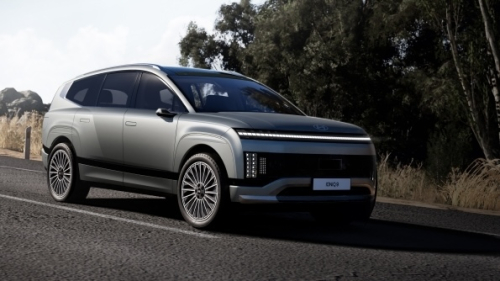IONIQ 9 is underpinned by Hyundai Motor’s E-GMP architecture, with enhanced power electronics system, with an optimized gear ratio for hill climbing and the application of a two-stage inverter for improved efficiency.

A fully encapsulated PE system helps reduce motor sound, while improved acoustic laminated glass, triple sealing in all areas and the application of a reinforced plate in the A-pillar area all help eliminate road and wind noise, vibration and harshness (NVH) inside the cabin.
The platform features a high-capacity, high-voltage battery for extended electric range and a flat floor for added passenger comfort and increased cargo space. Collision safety and durability have also been improved due to a robust body structure designed for optimal crash energy distribution.
IONIQ 9 is the first Hyundai model to feature aluminum fenders and quarter panels, contributing to a lightweight body that enhances the EV’s efficiency. The new dual-motion active air flap (AAF) system further enhances air sealing and exterior appearance with flush body panels.
The SUV also introduces a new closure system with a rolling-type pin-lift door hinge, ensuring a better fit and finish, and a newly developed electric hood latch for access to the front trunk, which not only improves the design but also enhances product quality.
The advanced high-voltage, floor-mounted NCM lithium-ion battery offers 110.3 kWh of system energy. IONIQ 9 is expected to achieve a WLTP-estimated all-electric range of 620 km and WLTP-targeted energy consumption of 194 Wh/km for the Long-Range RWD model with 19-inch wheels due to its low drag coefficient, advanced platform and battery technologies.
IONIQ 9 charges from 10 to 80% in 24 minutes using a 350 kW charger, while the platform’s vehicle-to-load (V2L) signature convenience feature and 400V/800V multi-charging capability lower the barriers to EV adoption.
The Long-Range RWD model is powered by a 160 kW rear motor, the Long-Range AWD alternative features an additional 70 kW front motor, while the Performance AWD models boast 160 kW motors at both the front and rear.
The Performance model can accelerate from 0 to 100 km/h in 5.2 seconds, while the Long-Range AWD variant takes 6.7 seconds, and the Long-Range RWD version takes 9.4 seconds. In terms of mid-range acceleration, such as overtaking other vehicles, the Performance model accelerates from 80 to 120 km/h in 3.4 seconds. The Long-Range AWD variant accomplishes this in 4.8 seconds, while the Long-Range RWD version takes 6.8 seconds.
IONIQ 9 features Hyundai’s latest Advanced Driver Assistance Systems (ADAS) aimed at improving safety by preventing accidents and easing driving tasks. These systems include Forward Collision-Avoidance Assist 2 (FCA), Lane Keeping Assist (LKA), Blind-Spot Collision-Avoidance Assist (BCA), Safe Exit Warning (SEW), Safe Exit Assist (SEA), Rear Occupant Alert, Intelligent Speed Limit Assist (ISLA), Driver Attention Warning (DAW), Blind-Spot View Monitor (BVM), High Beam Assist (HBA), Rear Cross-Traffic Collision-Avoidance Assist (RCCA), Parking Distance Warning (PDW) and more.
The SUV’s Chassis Domain Control Unit enhances driving performance with features such as dynamic torque vectoring for improved handling, and lateral wind stability control for high-speed stability. IONIQ 9 is also equipped with a Terrain Traction Control System for rough roads and an Auto Terrain Mode that uses AI to recognize the road surface and select the optimal driving mode.
The vehicle’s suspension system has been designed specifically to suit the application of an all-electric SUV, with a MacPherson multi-link setup at the front and a multi-link system at the rear. It includes self-leveling suspension dampers for added comfort and hydro-bushing to reduce driving vibration.
IONIQ 9 also offers competitive towing capabilities. In trailer mode, the vehicle automatically detects the trailer’s weight and adjusts predicted range accordingly. This feature maintains a fixed 50:50 front-to-rear motor torque distribution ratio for optimal performance. European IONIQ 9 models can tow up to 2,500 kg, while North American models have a towing capacity of 5,000 lbs.
In selected markets, Digital Side Mirrors replace traditional glass mirrors, displaying a side-rear view on a seven-inch OLED monitor. The system offers a zoom-out function for reversing, maneuvering guidelines, and an auxiliary line for lane changes. It provides safe, wide-angle rear-view vision even in difficult conditions, and further enhances the car’s aerodynamic performance.
IONIQ 9 has been engineered for reduced road noise levels, with specific considerations for the unique characteristics of EVs. The application of sound-absorbing tires minimizes tire resonance, while reinforcements to the vehicle’s structure adds rigidity and reduces low-frequency booming noise generated when driving on rough roads. The vehicle also features an Active Noise Control-Road (ANC-R) system[24] to further reduce road noise.
IONIQ 9 will go on sale in Korea and the United States in the first half of 2025, with subsequent rollout planned for Europe and other markets later. Detailed specifications will be unveiled closer to specific market launches.